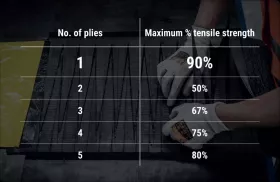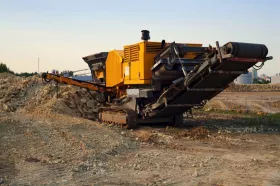
“The higher level of splice efficiency combined with the tensile strength of the X1 and X3 effectively creates equivalent tensile strengths and belt safety factors that are more than comparable to 3 or 4 layer conventional belting”.
Rob freely admits that finger splices are more costly but in his experience this reduces quite significantly with growing experience and the much longer operational lifetime being experienced more than compensates for the higher splicing cost. “The technical and economic arguments in favour of finger splicing are unquestionable.
Finger splice joints are stronger and more durable. Ultra X has an appreciably better performance compared to conventional ply belt so the need to repair and re-splice joints is much less frequent”.

“To help our customers we supply the splice kits including finger pattern templates, materials and tools, a guide manual and a training film. We even provide training and supervision where warranted”. For those who still want to avoid finger splicing, the good news is that Ultra X also possesses excellent mechanical fastener retention.
There certainly does not appear to be any question mark against the overall strength of Ultra X because, as their promotional film proudly states, an Ultra X3 single ply belt is able to pull up to 56 tonnes in weight.
Endless Opportunities

Yet another advantage is that Ultra X is flexible enough to be used on smaller drive pulley diameters, “The X1 drive pulley diameter for over 60% rated tension can be as small as 315mm and the X3 drive pulley diameter, again for over 60% rated tension, can be as small as 400mm” says Sales & marketing director Andries Smilda. “Ultra X can run on the kind of mobile machinery that has always been notorious for having small pulley diameters where the dynamic stress placed on the inner carcass and splice joint by the continual flexing over small diameter pulleys seriously limits what can be fitted. Ultra X overcomes that problem”.
Under the Radar
When Dunlop first launched Ultra X it was a deliberately low-key affair and under the radar of most of the market. Andries Smilda explains that they had many reasons for taking such a cautious approach. “We knew from the years of research and intensive laboratory testing that we were onto something special. But Dunlop being Dunlop we still wanted to prove it in the field so we worked with several tried and trusted end-users”. “Having sold many tens of thousands of meters has confirmed beyond doubt that Ultra X is all that we thought it would be and more. We have not had one single complaint or technical issue”.
Most significantly of all, Dunlop’s claims seem to be supported by the evidence. Ultra X is now the belt of choice for a growing number of OEM’s who have reported that Ultra X has more than doubled the average belt lifetime on their machines. In France, since replacing conventional multi-ply belts with Ultra X, a large aggregates quarry has seen an 87% improvement in productivity thanks to a dramatic reduction in stoppages caused by broken splices and other repairs. In Spain, one delighted cement plant operator has already seen a 50% increase in operating life and the belts in question still look as if they were fitted a matter of weeks ago rather than several months.
Competing on Quality and Price?
Dunlop are very open about the need to be able to offer prices that are at least comparable (and often lower than) multi-ply belting. “We would never would ever comprise on quality for the sake of competing on price. That is simply not our culture and it is not necessary anyway because there are several reasons why we can price Ultra X so competitively” says Mr. Smilda.

“Firstly, the single-ply carcass is made from fabric that we manufacture in-house. That is a big, big advantage in terms of quality and cost. Having a single-ply construction also helps to maximise efficiency of production because there are fewer calender runs. And having no rubber skim between the plies not only results in a thinner, stronger carcass, it also keeps the cost down. We are also making longer production runs at a maximum width of 2000 mm”.
A Cultural Change?
To many, the idea that a single-ply construction belt can provide the necessary tensile strength while possessing considerably more resistance to ripping, tearing and impact is difficult to comprehend, especially while also competing on price, which is something Dunlop are not usually recognised for. However, conveyor operators can perhaps look beyond traditional beliefs and thinking then I strongly suspect that Ultra X really could be a real winner for them.
■



















